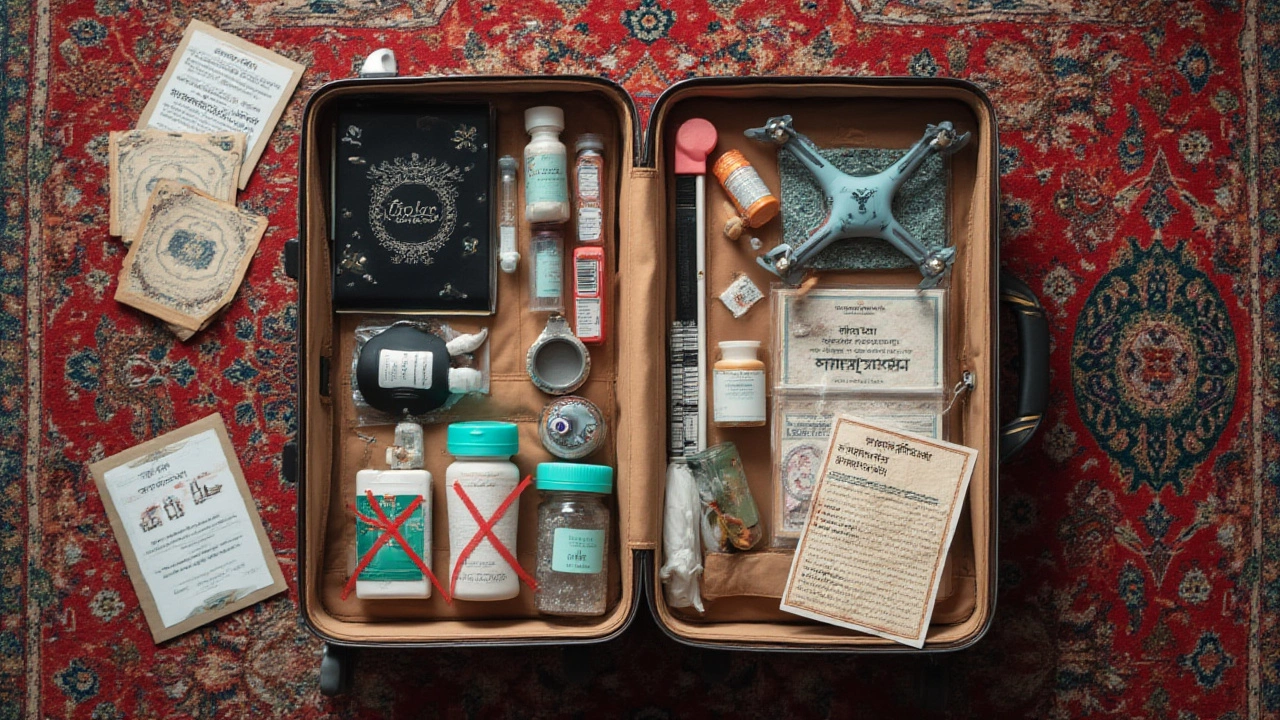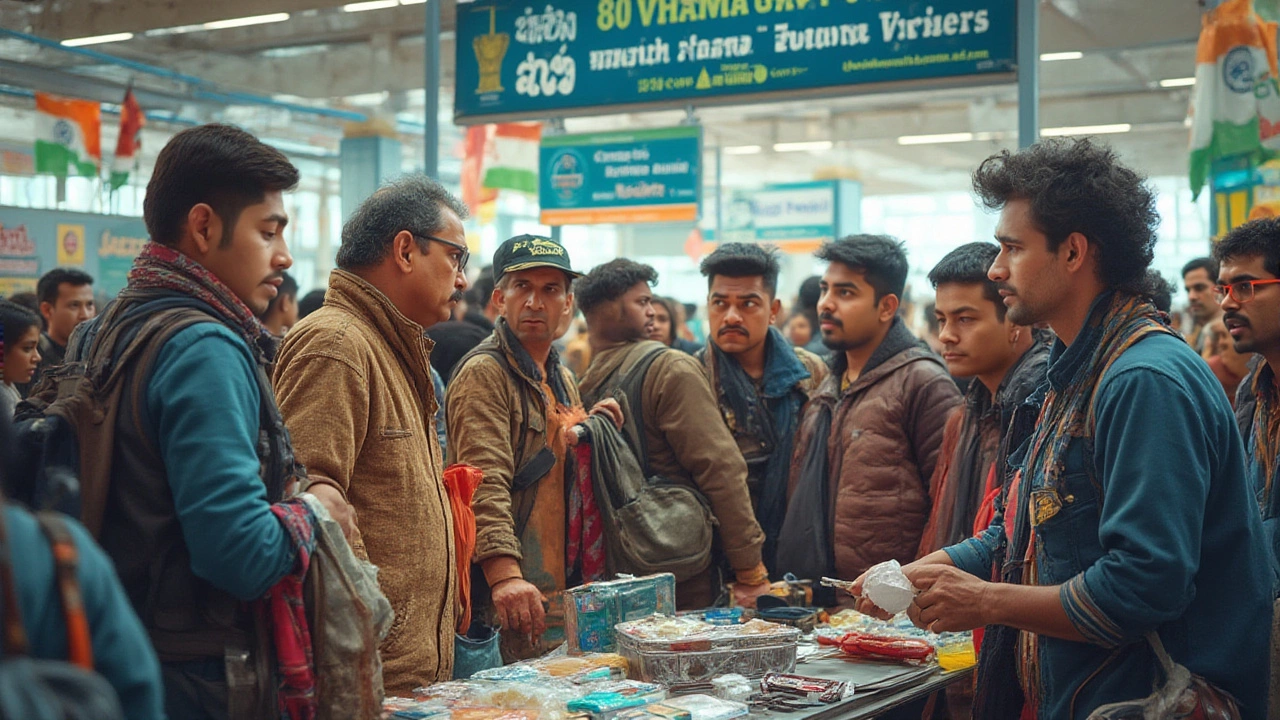Picture getting flagged at customs, realizing your charger won’t fit, or fumbling with impractical shoes in the middle of a bustling bazaar. Packing for India isn’t just about what to bring—it’s about what to leave at home. Tons of travelers get this wrong, and it can ruin the start of a once-in-a-lifetime trip. The right packing list for India looks very different from the lists you’d make for Europe, the US, or Southeast Asia. Get it wrong and you’ll spend your first few days stressed, searching for replacement chargers, or even dealing with legal headaches. Get it right, and you’ll glide through airports, temples, and train stations feeling like an insider. Now, let’s talk about the stuff you should absolutely skip.
Items You Should Never Pack for India
If you think you can fly into India with anything in your suitcase, think again. Indian customs is strict about certain items. Drugs—even cannabis products that are legal in some countries—will land you in serious legal trouble here. There are well-documented cases of travelers detained for months over a few grams of marijuana or even CBD oils. Prescription medications can also be a minefield. Indian law allows tourists to carry personal medicines, but you need to bring a copy of your prescription and ideally, a doctor’s note explaining what the medicine is for. Anything that looks suspicious or isn’t labeled can be confiscated or worse. One French backpacker made headlines when her allergy medication was mistaken for narcotics. Don’t risk it—if you need meds, keep them in original packaging, carry documentation, and make sure they aren’t banned in India.
You also can’t just bring in unlimited amounts of cash. Anything over $5,000 USD (or the equivalent) in cash will need to be declared. Forget bringing Indian rupees in—customs actually prohibits bringing in any Indian currency from abroad. Credit cards, debit cards, and mobile wallets like Google Pay are used widely, especially since the 2016 demonetization that shocked locals and travelers alike. It’s best to arrive with a small amount of foreign currency and withdraw rupees from bank ATMs once you land. The current ATM withdrawal fees are usually around 200 INR per transaction for foreigners, so withdraw larger amounts instead of making repeated trips to the ATM.
There are a few things that might seem harmless but aren’t. Satellite phones, for example, are a no-go and will get confiscated at the airport. Drones are another headache; India has tough regulations and you need special permits to legally fly them, even for recreational use. A British travel vlogger’s drone was confiscated at Delhi airport just last year when he couldn’t show paperwork.
Many Western travelers love e-cigarettes and vapes, but India banned the sale, import, and advertisement of these products in September 2019. This law is taken seriously—hundreds of travelers have had their vapes confiscated. If you’re caught selling or distributing vapes, you could face jail time or huge fines. In short: leave all vaping equipment at home.
Seen those cheerful red cans of pepper spray in your local shop? Self-defense sprays are illegal in India unless you have police permission—which the average tourist doesn’t. Personal alarms are a better alternative for feeling safe. Police across India encourage travelers to carry these instead, as they’re legal, easy to buy in-country, and more socially accepted.

Packing Mistakes That Make Traveling in India Harder
Even if an item is technically legal to bring in, it might be totally useless, or even a liability, on the ground in India. Heavy suitcases are a prime example: India’s streets are not made for wheely bags. Many cities have uneven sidewalks (if any), and lots of old buildings have rough staircases and no elevators. You’ll dread every moment you need to move your luggage. In the last five years, countless travel forums have filled with stories of wheeled suitcase misery. Locals, expats, and return visitors all say the same thing: bring a good backpack. It keeps your hands free, handles uneven terrain, and is easier to carry in crowded places.
Let’s talk shoes. It can be tempting to pack your favorite sneakers with flashy logos or your trendy sandals. But the reality in India? Your shoes will get dirty—really dirty. Dust, monsoon mud, temple visits (where you remove your shoes), and crowded streets all take their toll. It’s smarter to bring sturdy, closed-toe shoes you don’t mind getting beat-up. Flip-flops or slip-on sandals work well for indoors, showers, and quick trips. Do not bring only nice shoes: you will regret it.
Some travelers assume they’ll need fancy clothing for evenings out, but most places in India are surprisingly laid-back about dress codes. Stick to lightweight, modest clothes that handle sweat and sun well. Synthetic, non-breathable fabrics spell regret in the heat. Natural fibers like cotton and linen will save you. Avoid bringing shorts and tank tops if you want to blend in—especially when visiting temples or smaller cities. You’ll feel out of place and may even be denied entry.
Adapters and voltage differences trip up a lot of first-timers. India uses 230V, 50Hz electricity and typically Type C, D, and M plugs. Most modern electronics like phone chargers will handle the voltage, but check before you plug in. Forgetting the right adapter means you’ll be on a frantic early-morning scramble for a replacement. Buy universal adapters in your home country—they’re cheaper and more reliable than the ones you’ll find on the street.
Fancy toiletries or full makeup kits also tend to go unused. Between the heat, humidity, and air pollution, you’ll find that minimalism is best. Stick to small toiletries and plan to buy extras locally. India’s pharmacies and supermarkets carry all the basics, and the prices are often lower than at home. Shampoo and sunscreen, for instance, are found everywhere—just remember to bring brands you trust if you’re picky about ingredients.
And yes, Indian tap water is not safe to drink, even if you’re used to roughing it. But there’s no need to pack bulky water filters or fancy straws. Bottled water is available everywhere, and many hotels and upscale restaurants provide safe, filtered water. Instead, pack a reusable bottle—some hotels offer free, filtered refills. A UV sterilizer pen is handy if you’re out in rural areas, but for city travel, you won’t need anything more intense.

Travel Tips and Surprising Facts to Make Packing Easier
Most travelers forget how cheap and easy it is to pick up essentials in India. There’s a thriving culture of street markets, pharmacies, and small stores selling everything from power banks to socks. The “bring everything” mindset is simply outdated when you can shop local for a fraction of the price. Indian-made clothing, like lightweight kurtis and loose-fit pants, is not only comfortable but blends in better than any imported brand. It’s not uncommon for seasoned travelers to India—especially those coming for yoga retreats or long backpacking trips—to pack almost nothing and buy what they need on arrival.
Bring copies of your passport, visa, and important documents, but there’s no need for a file folder thick as a novel. Scanned copies stored in cloud storage or on your phone are accepted by most hotels, police officers, and travel agencies. A recent study by the Indian Ministry of Tourism found that travelers carrying only digital backups are usually not hassled, as long as they can unlock the files quickly. Still, a few hard copies, sealed in a waterproof pouch, can be a lifesaver if your phone dies—especially in remote areas where charging can be a challenge.
Tech gear deserves another mention. India’s street markets are famous for cheap, knockoff electronics, but quality is hit-or-miss. Portable chargers, USB cables, and travel adapters are best brought from home to avoid reliability issues. On the other hand, don’t stress about things like SIM cards—getting one in India is easier and cheaper than ever, thanks to digital KYC laws rolled out in 2023. Expect to register with your passport at any major airport or mobile store and get local data within an hour.
One mistake people make is bringing heavy guidebooks or paper maps. India’s infrastructure changes quickly, with new roads, metro lines, and hotel closures happening almost overnight. Apps like Google Maps and Maps.me are far more reliable. Download offline city maps before you arrive; paper guides will quickly become out of date and take up valuable space.
Let’s talk souvenirs and gifts. You might think bringing chocolates or alcohol as gifts for hosts or guides is polite, but India has strict alcohol import rules: only one liter per adult, and that too only if you’re over 25 (age varies by state). Many types of cheese, cured meats, or non-vegetarian foods are outright banned. Instead, bring small, nicely packaged items from your home country—think postcards, keychains, or beauty samples. Locals appreciate the gesture, and you won’t risk a fine.
Recent data from India’s Central Board of Indirect Taxes and Customs showed a surprising rise in confiscated animal products—especially seashells, coral, and ivory souvenirs picked up on the way to India from other countries. Even if these items are legal elsewhere, they’re banned in India to protect endangered species. Don’t take the risk; these items get flagged on X-ray and will end up in the customs “hall of shame.”
There’s also a growing awareness of sustainability among Indian travelers and hosts. Single-use plastics—including straws and thin plastic bags—have been banned in several states. Bringing plastic water bottles or disposable cutlery is not just unnecessary, it’s frowned upon. Consider packing a foldable tote bag and bamboo utensils if you want to make a good impression and avoid fines.
One last thing: expensive jewelry and flashy watches. India is generally very safe, but pickpocketing happens in busy tourist spots. Don’t risk losing sentimental or pricey items—leave them at home. The same goes for high-end cameras, unless photography is your passion and you’re comfortable carrying gear all day. A newer smartphone with a good camera will be enough for most people. Most city police reports list jewelry theft as the top tourist crime, especially around major temples and fairs.
To wrap this up: pack less, choose practical items, leave restricted goods at home, and remember, India will surprise you with how easy it is to get every little thing you need once you land. That’s the real India travel hack nobody tells you. When you lighten your load, you gain experiences, not just souvenirs.
